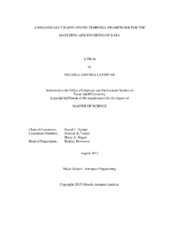| dc.description.abstract | This thesis presents a neuron model and framework for the architecture and interaction of neurons in order to accomplish two tasks, 1) data matching, and 2) the storage and retrieval of information. The tasks are approached from the basis of biologically inspired spiking neural network theory. The fundamental aspects of this model are extracted and implemented in conjunction with the designed framework, resulting in a model that takes advantage of the spatio-temporal nature of neurons to match, store, and retrieve data. The driving features are the rest, or refractory, period of the neurons, and the finite, positively sloped post-synaptic responses. When superposed these responses may increase a neuron’s potential past the threshold, causing the neuron to fire. A framework, the Competitive Classifying Unit, composed of groups of dynamic threshold neurons is used to match binary strings, with and without noise present. In the absence of noise, results show an increase in accuracy with decreasing standard deviation in the randomness of the neuron threshold. With noise present, the framework retains its ability to identify the specified sequence.
To realize the second task, an additional architectural structure for storing and retrieving data based on the spike time arrival is presented. Training pulse arrival times in conjunction with firings caused by upstream neurons result in synapse weight adjustments. Ultimately, the data is storable and retrievable due to the synapse connections developed between neurons in a network, synapse connections that are either strengthened or pared away during training. Due to the precise timing requirements of system, a clock is required to measure the passage of time. This necessity which implies periodicity, synchronicity is supported by the number of upstream neuron firings required to cause a downstream neuron to fire, and all of this is supported by homeostasis constraints. Finally, the limits for data storage capacity (i.e.: the number and length of binary strings) is determined based on number of neurons in a neuron cluster. | en |


